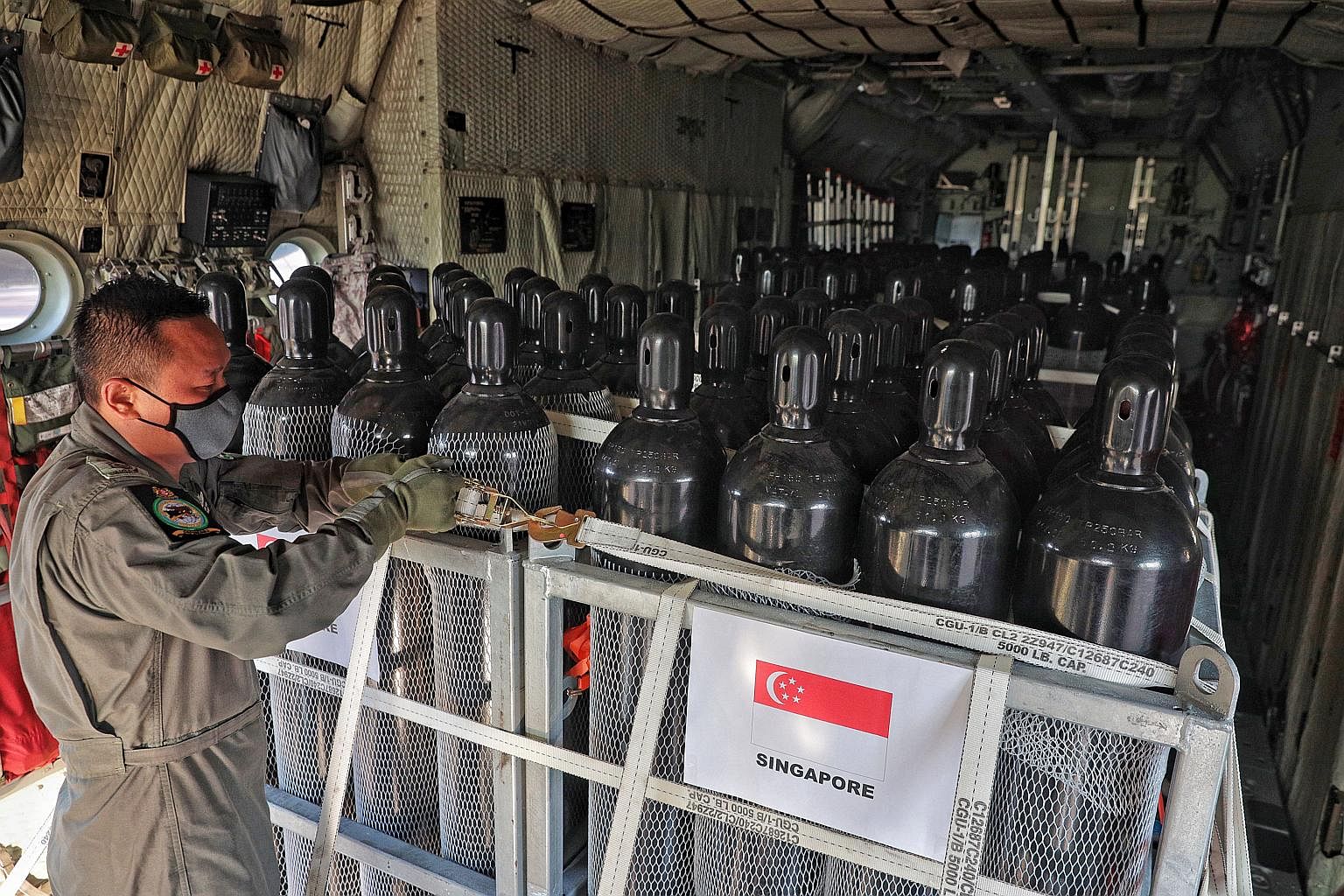NEW DELHI - The biggest international relief mission India has seen in recent years is being rolled out as the country reels from the impact of a second wave of Covid-19 that has put inordinate pressure on its health infrastructure and resulted in shortages of oxygen, medicines and other equipment.
Every day, flights from different countries carrying emergency relief ranging from large oxygen-generating plants to N95 masks have been landing in Delhi, Mumbai and Chennai.
Ships carrying liquid medical oxygen and other oxygen-related equipment are also docking in ports, emptying their cargo and going back for more rounds.
From airports and ports, oxygen and oxygen-related equipment, medicines like remdesivir and other equipment like ventilators and oximeters are being sent to different parts of the country most affected by the second Covid-19 wave.
The capital city, Delhi, which has been among the worst affected with hospitals running out of oxygen and patients in desperate need for medical help, has been a key recipient of this foreign aid, which started arriving on April 27.
Ventilators from Thailand have gone to Safdarjung Hospital in Delhi, an Italian oxygen plant to the ITBP hospital in Greater Noida. Five oxygen generating plants sent by France have gone to Delhi government hospitals, including the Sanjay Gandhi Memorial Hospital.
Similarly, aid from Singapore has also reached Delhi.
On Thursday (May 6), five ventilators sent by Singapore Red Cross arrived in Delhi and were earmarked for Delhi hospitals.
"At the government level, 256 oxygen cylinders were airlifted by the Republic of Singapore Air Force on April 28 and handed over to the Indian Red Cross. The latter is best-placed to distribute supplies where they are most needed," said Singapore's High Commissioner to India Simon Wong.
"Beyond that, we have worked closely with the Indian government on the commercial procurement of oxygen tanks. At the ground level, there are Singapore companies and NGOs either channelling contributions via the Singapore Red Cross or working directly with local partners."
Hindustan Times newspaper reported that oxygen cylinders from Singapore had been sent to All India Institutes of Medical Sciences in the cities of Raipur, Ranchi, Bhubaneswar.
Singapore's Temasek has partnered a growing coalition of private and public sector organisations to donate more than 8,300 oxygen concentrators, 51,000 oximeters as well as ventilators. Some two million masks and other equipment are also on the way.

Over 40 countries have responded to the massive humanitarian crisis that has unfolded in different parts of India.
India has recorded over 20 million Covid-19 cases, with highs such as 412,262 of them in the 24 hours up to Thursday.
Predictions are that the peak could start dipping either in the middle or end of May. Some models have predicted it will continue till June.
Prime Minister Narendra Modi's government has faced criticism from sections of the Indian media and the opposition that it did not mobilise fast enough. It has also been accused of lacking transparency over how it is allocating the foreign aid.
"The nation expects transparency from the government at every step," said Congress spokesman Pawan Khera.
Congress leader Rahul Gandhi on Twitter asked for a listing of the items and their destinations.
Media reports, too, have highlighted delays.
The Scroll.in, an online news portal, reported that aid disbursement started only on May 3, a week after foreign relief started pouring in.
The government claims "a swift distribution of Covid-19 foreign aid to states, hospitals await supplies", said Scroll.in an article on Wednesday.
India Today, in an article, also criticised the government of being slow even as the oxygen crisis deepened.
In the Delhi High Court, Indian media reported that senior advocate Rajshekhar Rao expressed concern with the way medical equipment was being distributed.
He was quoted as saying in court that Lady Hardinge Medical College received around 260 oxygen concentrators when it did not require that many.
Still, the government of India has denied the criticism and media reports of delays, saying that aid had been sent to 38 medical institutions in 31 states.

In a statement, it described the flow of aid - the Ministry of External Affairs coordinates with the aid-giving countries, the Indian Red Cross Society receives it and hands it over to HLL Lifecare Limited, a central government company. A unit under the Ministry of Health then decides where the equipment would go to.
Sources said the countries that have sent help are being told where the aid is going.
The Ministry of Health and Family Welfare in a statement: "All items received so far are allocated to the states/institutions and a substantial part of it stands delivered. This is an ongoing exercise."













